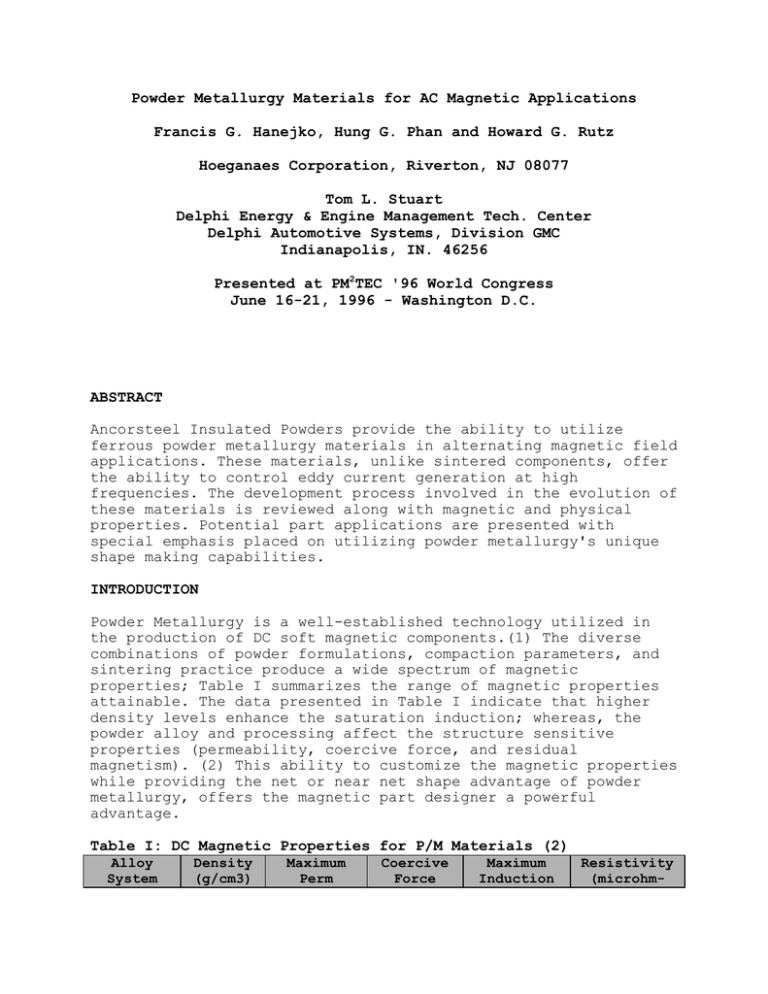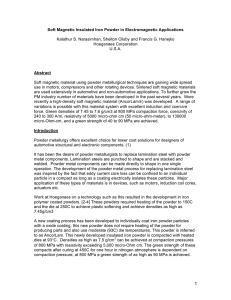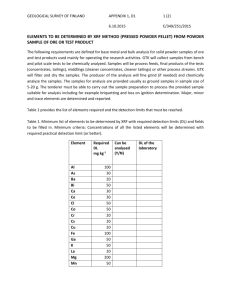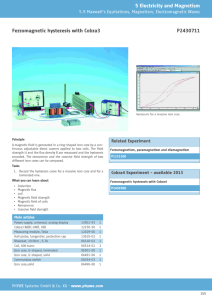Powder Metallurgy Materials for AC Magnetic Applications
advertisement

Powder Metallurgy Materials for AC Magnetic Applications Francis G. Hanejko, Hung G. Phan and Howard G. Rutz Hoeganaes Corporation, Riverton, NJ 08077 Tom L. Stuart Delphi Energy & Engine Management Tech. Center Delphi Automotive Systems, Division GMC Indianapolis, IN. 46256 Presented at PM2TEC '96 World Congress June 16-21, 1996 - Washington D.C. ABSTRACT Ancorsteel Insulated Powders provide the ability to utilize ferrous powder metallurgy materials in alternating magnetic field applications. These materials, unlike sintered components, offer the ability to control eddy current generation at high frequencies. The development process involved in the evolution of these materials is reviewed along with magnetic and physical properties. Potential part applications are presented with special emphasis placed on utilizing powder metallurgy's unique shape making capabilities. INTRODUCTION Powder Metallurgy is a well-established technology utilized in the production of DC soft magnetic components.(1) The diverse combinations of powder formulations, compaction parameters, and sintering practice produce a wide spectrum of magnetic properties; Table I summarizes the range of magnetic properties attainable. The data presented in Table I indicate that higher density levels enhance the saturation induction; whereas, the powder alloy and processing affect the structure sensitive properties (permeability, coercive force, and residual magnetism). (2) This ability to customize the magnetic properties while providing the net or near net shape advantage of powder metallurgy, offers the magnetic part designer a powerful advantage. Table I: DC Magnetic Properties for P/M Materials (2) Alloy System Density (g/cm3) Maximum Perm Coercive Force Maximum Induction Resistivity (microhm- Fe Fe/P Fe/Si 400 Series SS 50Ni/50Fe (Oe) (G) cm) 6.8-7.2 6.8-7.4 6.8-7.3 6.7-7.2 1800-3500 2500-6000 2000-6000 1400-2100 1.5-2.5 1.2-2.0 0.8-1.2 1.5-2.0 10-13 10-14 9-13 9-11 10 30 60 50 7.2-7.6 500015000 0.2-0.5 9-14 45 Primary markets utilizing sintered soft magnetic P/M applications are the automotive and lawn and garden sectors. (3) Apart from these markets, the vast majority of electrical devices utilize AC (alternating current). The electrical motors that power home appliances, transformers that power industry, and modern electronics all rely on AC electrical power. Table II summarizes the US market for soft magnetic materials for calendar year 1995 and the projected usage in the year 2000. The estimated usage of electrical materials for AC applications will grow at a 5.4% annual rate, with the total sales approaching $3 billion by the end of the decade. (4) In comparison, the total quantity of iron and steel powders shipped in 1994 was 338,000 tons with a sales value of less than $0.5 billion. (5) Clearly, the market for AC electrical material is significantly larger than P/M. Developing suitable powder materials and processing to satisfy the requirements of this industry would contribute significantly to the growth of P/M. Table II: World Wide Usage of Electrical Steels (4) Magnetic 1995 2000 Growth Rate (%) Material $ Millions $ Millions (1995-2000) Steel 1,818 2,364 5.2 Ceramic 270 416 9.0 Other Metallic 119 158 5.8 Total 2,207 2.938 5.4 Electrical steels are manufactured as thin gage strip that is stamped, often annealed, and assembled into laminated structures. The unique shapes of motor stators and rotors often result in high percentages of scrap when formed by the stamping process. Powder metallurgy's shape making capability and high material utilization seemingly offers considerable economic advantage in the production of electric motors, transformers and the like. Why then is P/M not specified for the manufacture of AC electrical devices? The most basic answer can be related to the eddy currents generated within ferromagnetic materials when the material is exposed to alternating magnetic fields. (6) These eddy currents result in heat generation within the component; the eddy current losses can be expressed by the following equation: Eddy Current Loss = Ke d2 B2 f2/p [1] In which “Ke” is a constant “d” is the thickness of the material, “B” is the magnetic induction, “f” is the frequency, and “p” is the electrical resistivity of the ferromagnetic material. As the thickness of the material is increased, the eddy current losses increase in proportion to the thickness of the lamination or component to the second power. Thus, doubling the thickness will result in a four-fold increase in the eddy current losses. It is for this reason that AC machines utilize laminations. Laminations minimize the eddy current losses within the assembly by restricting the eddy currents to the surface of thin laminations. Typical steel lamination thicknesses are in the range of 0.007 inch to 0.020 inch (0.18 to 0.50 mm). Attempts at manufacturing laminations via powder metallurgy techniques have been unsuccessful. Compaction processing has as a practical lower limit a thickness of approximately 0.060 inches (2.4 mm) (7); this minimum thickness for P/M is significantly thicker than the thickest lamination steels. Thus, the inherent eddy current losses of pressed and sintered P/M laminations will be significantly higher than conventional steel assemblies. Additional problems associated with the production of P/M laminations are the flatness requirements and the inherent higher cost associated with the P/M technique relative to stamping technology. Two distinct approaches applying powder metallurgy techniques to AC devices are utilized in the production of transformer cores for switched mode power supplies and loading coils utilized in telephone circuitry. Cores for switched mode power supplies are manufactured by first treating the surface of a high purity, high compressibility iron powder with a phosphoric acid. (8) After the initial insulation is applied, the powder is mixed with a compaction lubricant and a thermoset resin. Once compacted, the core is cured to initiate the reaction of the thermoset resin to give mechanical strength to the part. The advantage of this technology is the minimization of eddy currents in high frequency AC applications. Limitations of this process are the finished component's relatively low strength and the cold work of the iron powder introduced during compacting which detracts from the magnetic performance. Cores used in telephone circuitry utilize a highly alloyed powder, either molybdenum permalloy or sendust, which is premixed with a ceramic powder that acts as the insulating medium. (8) Compaction is performed at pressures up to 100 tons per square inch (1,370 MPa) and following compaction the cores are magnetically annealed. Annealing is required to minimize the deleterious effects of cold work on the magnetic performance of the core material. This technology is limited by high material cost and the utilization of very high compaction pressures. The advantage is that the post compaction annealing step eliminates the cold work introduced during compaction thus improving the magnetic performance. INSULATED IRON POWDER At the 1995 International Conference on Powder Metallurgy & Particulate Materials, two presentations discussed the technique of coating iron powder with a thin layer of a high performance thermoplastic. (6,9) The coating was applied utilizing fluid bed technology, allowing the application of minimal coating thickness while maintaining insulating characteristics. This coating technology, in conjunction with hot powder compaction techniques, produced higher part densities than previously attainable. The higher component densities improved the magnetic performance. In addition, the uniform dispersion of the high performance plastic produced enhanced strength of the as-compacted component, approaching 10X the green strength of non-coated iron powder. Table III summarizes the green density and green strength of both conventionally compacted material and that of the microencapsulated iron powders. Table III: Encapsulated Green Strength and Density Data Process Parameters Powder Temperature Die RT 75°F 125°F 175°F 225°F Temperature RT 150°F 250°F 350°F 450°F Standard P/M -- Admixed Lube 6.92 6.94 6.97 6.97 7.1 Density (g/cm3)* 2250 2310 2750 3100 3250 TRS (psi) Microencapsulated Powder 7.04 7.08 7.07 7.15 7.18 Density (g/cm3)* 3448 3224 4343 4732 10670 TRS (psi) * Compacted at 50 tsi 225°F 550°F 7.05 4150 7.25 16660 The data demonstrates clearly the higher density attained by warm compaction techniques. Also, by encapsulating the iron powder, the as compacted strength improved significantly. Further improvements to the strength of microencapsulated iron powder were realized when the component was subjected to a post compaction curing cycle. The 600°F (315°C) thermal cycle improved the green strength to approximately 35,000 psi (240 Mpa). (6) Magnetic performance of the plastic microencapsulated iron powder is summarized in Table IV. Permeability, maximum induction, and resistivity vary with the amount of plastic and pre-insulation of the iron powder. Distinct grades were developed that maintain constant permeability for various frequency ranges. It was demonstrated that the total magnetic core losses of these materials in that constant permeability range were dependent upon the hysteresis loss of the material. Eddy current losses are minimized in the constant permeability range by the selection of coating thickness and particle size distribution. This elimination of the eddy current losses for plastic coated material resulted in lower total losses at higher operating frequencies. Table IV: Magnetic Performance Data of Plastic Coated Iron Powder Material Initial Maximum Coercive Induction Permeability Permeability Force at 40 Oe (Oe) (G) SC120 120 425 4.7 11,200 SC100 100 400 4.8 10,900 TC80 80 210 4.7 7,700 Notwithstanding the advantages of higher densities and reduced amounts of insulation, the compaction of the coated iron powders introduces cold work into the iron particles, thus increasing the coercive force of the material (to approximately 5 Oe). As discussed earlier, the plastic coated iron powder minimizes the eddy current losses but the hysteresis loss portion of the total core loss is now dominant. The hysteresis loss can be represented by the following equation: Hysteresis Loss = KH x Loop Area x f [2] in which “KH” is a constant, “f” is the frequency, and the “Loop Area” is the measured DC loop area of the hysteresis curve. The total core loss of a magnetic device is the sum of the eddy current losses and hysteresis losses (the summation of equation 1 and equation 2). In conventional laminated steel assemblies, the eddy current losses increase dramatically as the frequency increases, because they are proportional to the frequency squared. One way to minimize the total core loss is reduce or eliminate the eddy current losses. The insulated iron material described in references 6 and 9 clearly demonstrates that these materials minimize the eddy current losses by restricting the eddy currents to a small iron particle. Shown as Figure 1 are the hysteresis curves for a steel lamination assembly tested under DC conditions, at 50Hz, and at 500Hz. When tested under DC conditions the lamination assembly exhibits a maximum permeability of approximately 2000 with a “square” hysteresis curve. When the applied magnetic field begins to vary with time, the shape of the B-H curve becomes oval and the total loop area increases dramatically. The cause of this broadening of the B-H curve is the detrimental effect of the eddy currents that results in a lowering of the magnetic performance at higher frequencies. Figure 2 shows the magnetization curves for Ancorsteel SC120 tested under DC conditions, at 50 HZ and at 500 Hz. The DC magnetic properties of the insulated iron are inferior to the conventional lamination steel assembly. For example, the maximum permeability of the steel laminations is approximately 2000; whereas, the insulated iron material is approximately 450. However, as the magnetizing field begins to vary with time, the shape of the B-H curve for the insulated iron remains constant. There is a broadening of the curve resulting from the higher frequency (predicted from Equation 2), but the curve is not changing to an oval as observed with the laminated steel assembly. The significance of the constant shape of the B-H curve is the minimization of eddy currents at the higher frequency. If the total loop area is compared for the two materials, it is observed that the insulated iron has a higher loop area up to approximately 1000 Hz but above that level, the laminated steel assembly has a greater loop area. This implies that the insulated iron material is more efficient at the higher frequencies and will make a better core material in this operating range. Figure 1: Hysteresis Curves for Lamination Steel Figure 2: Hysteresis Curves for Ancorsteel SC 120 Table 5 summarizes the permeability and core loss at a 10 Gauss induction level of the lamination assembly and the Ancorsteel SC120 material. Note the permeability of the lamination stack starts at a relatively high level compared with the insulated iron material but it decreases as the frequency increases. Coincidental with the decrease in permeability is the increase in core loss. The insulated iron has a greater core loss at lower frequencies because of the higher hysteresis losses. However, as the frequency increases, the increase in core loss is less dramatic compared with the lamination material. As discussed earlier in this report, the insulated iron powder can be prepared so as to have constant permeability up to 50,000 Hz. In applications requiring these very high frequencies, the superiority of the insulated material is more significant. The implication of this trend is that the magnetic part designer can utilize the constant permeability of the insulated iron materials over a broader frequency range without the corresponding increase in eddy current losses. Table V: Initial Permeability and Core Loss, Lamination Assembly and Ancorsteel SC120 Lamination Stack Ancorsteel SC120 Frequency Initial Core Initial Core Permeability Loss Permeability Loss (µW/cm3) (µW/cm3) 100 220 0.08 89 4.18 200 500 1000 2000 5000 10000 221 220 211 182 112 70 0.21 0.91 3.2 12.4 96 379 89 89 88 88 79 65 4.31 4.88 6.47 6.47 48.1 181 CHALLENGES A trend in the electrical motor market is the increasing usage of brushless DC motors and variable speed AC drives. Unlike traditional AC motors, these new types offer variable rotor speed without the corresponding loss of performance that is associated with simply varying the frequency of an induction motor. (10) Variable speed drives are particularly useful in constant duty applications where constant rotor speed and torque output are not necessary. Examples of these applications are compressors for air conditioning and refrigeration. Energy savings can be realized by matching the output of the compressor to the need for cooling. Energy efficiencies up to 90% are possible with these new designs. Insulated iron powder offers the constant magnetic performance over a wide frequency range coupled with the potential for lower total losses at the higher operating frequency. Insulated iron powder also offers the designer three dimensional design flexibility and three dimensional flux carrying capability that is not possible in conventional laminated assemblies. For P/M to gain a greater foothold in the AC magnetic market, the industry must develop new materials and processing technology to meet the new market opportunities. The trends toward high efficiency motor designs and electronic materials will necessitate increased operating efficiency with concurrent lower manufacturing costs. If powder metallurgy is to participate in this growing market, new materials and processing will be required. Higher permeability and lower loss materials are one key to opening this market for P/M. As discussed earlier, the total core loss of the insulated iron materials is dependent upon the hysteresis loss of the iron powder. The cold working imparted to the iron during compaction results in the coercive force increasing from 1.7 Oe for a sintered material to in excess of 4.5 Oe for the compacted insulated iron material. The key to lowering the coercive force is either to develop a coating that can withstand annealing temperatures or development of compaction technology that does not introduce the deleterious cold work. Figure 3: The Permeability of NANOCOM Material One technique to eliminate the deleterious effects of cold working the iron powder was pioneered by Dr. Kugimiya. (11) In this technique, the surface of the powder was first oxidized; the powder was then hot pressed to full density (this material is referred to as “NANOCON” material). This processing produced high bulk resistivity with excellent permeability and low total core losses. Figure 3 shows the permeability vs. frequency response of the “NANOCON” material relative to the bulk sendust material. It was interesting that the maximum permeability of the oxidized and hot pressed sendust was approximately 25% of the bulk sendust material. However, the high frequency permeability surpassed that of the bulk material. At present, hot pressing is not an economical process for the mass production of commercial components. Ideally, the most cost effective production method is to die compact an insulated iron powder and follow the compaction step with a low temperature anneal to reduce the internal stress of the iron powder. If the coercive force were reduced to 1.7 Oe, the total core loss of the insulated iron material would decrease approximately 50%. This reduction of total core loss would expand the usage of insulated iron materials in a greater diversity of AC magnetic applications. In the manufacture of powder components, new compaction technologies are being explored that could eliminate the cold working of the iron powder. New tooling lubrication techniques are needed to significantly reduce the need for premixed powder lubrication. Additionally, the P/M part fabricator should continue to identify and pursue new market opportunities beyond the current application base of P/M. The market opportunities in the AC electrical arena offer excellent growth opportunities for P/M. With the greater emphasis on high efficiency electrical motors, high frequency transformers and more diverse consumer electronics, the P/M industry has only scratched the surface of this exciting market. CONCLUSIONS This paper demonstrated the advantages of insulated powder P/M technology for high frequency AC applications. Insulated iron powder offers new possibilities for improvements in electrical machine performance, material cost and probably most important of all, new production possibilities. One of the keys is to invite radically new design directions. The designer needs to design with P/M from the start to full utilize the advantages of the product. The growing market for electrical materials is an excellent opportunity for P/M expansion into new applications. A unified effort encompassing the entire P/M industry will be required to meet the challenges and satisfy these new demands. It is a worthwhile effort as the rewards can be great. ACKNOWLEDGMENTS The authors wish to acknowledge the support of both Hoeganaes Corporation and Delphi Energy & Engine Management, Delphi Automotive Systems - General Motors Corporation in the preparation of this paper. REFERENCES 1. Lall, C., Baum, L. W., “High Performance Soft Magnetic Components by Powder Metallurgy and Injection Molding”, Modern Developments in Powder Metallurgy, Vol. 18, compiled by P. Ulf Gummeson and Donald A. Gustafson, 1988. 2. Hanejko, F. , Rutz, H., Oliver, C., “Effects of Processing and Materials on Soft Magnetic Performance of Powder Metallurgy Parts”, Advances in Powder Metallurgy & Particulate Materials, 1992, Vol. 6, compiled by Joseph M. Capus and Randall M. German, pp 375-404, Metal Powder Industries Federation, Princeton, NJ. 3. Lall, C., “Soft Magnetism, Fundamentals for Powder Metallurgy and Metal Injection Molding”, Nomographs in P/M Series No.2, 1992, Metal Powder Industries Federation, Princeton, NJ. 4. Abraham, T., “U.S. Industry and Market Overview of Soft Magnetic Materials”, Soft Magnetic Materials 96”, February 2628,1996, Gorham/Intertech Consulting. 5. White, D. G., “Powder Metallurgy in 1995”, Advanced Materials & Processes, August 1995 pp 49-51. 6. Oliver, C.G., Rutz, H. G., “Powder Metallurgy in Electronic Applications”, Advances in Powder Metallurgy and Particulate Materials”, compiled by Marcia Phillips and John Porter, Vol. 3, Part 11,1995, pp.87 - 102, Metal Powders Industries Federation, Princeton, NJ. 7. Powder Metallurgy Design Manual, 1995, p 23, Metal Powder Industries Federation, Princeton, NJ. 8. Inc Bozarth, R., “Ferromagnetism”, 1959, D. Van Nostrand Co., 9. Gay, D. E., “Higher Performance Microencapsulated Powders for Various P/M Applications”, Powder Metallurgy in Electronic Applications”, Advances in Powder Metallurgy and Particulate Materials'; compiled by Marcia Phillips and John Porter, Vol 3, Part 11,1995, pp 106 - 126, Metal Powders Industries Federation, Princeton, NJ. 10. Garrison, P. G., Paul, B. 0., “Variable-speed AC Drive Selection”, Chemical Processing, May 1996, pp 68-71. 11. Kugimiya, K., “Nanocom Materials”, Soft Magnetic Materials 96”; February 26-28,1996, Gorham/Intertech Consulting.







